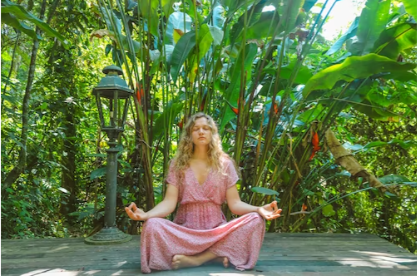Are Meditation and Yoga the Same?
Discover the differences between meditation and yoga. Meditation focuses on the mind, whereas yoga focuses on the body.

Selfpause Affirmation App
Download the app to get 1,000’s of affirmation meditations and everything you need to write, record and listen to your own.
If you are looking for a way to cultivate self-awareness, try meditation or yoga. These two practices help you get out of your head and reconnect with your body. However, there is a difference between them. Meditation focuses on the mind, while Yoga focuses on the body.
Meditation is a form of self-awareness

Self-awareness is the ability to observe all that is happening in the moment without attachment to what is happening. When practicing yoga, meditation and other contemplative practices, we practice becoming a witness and non-attached observer of our thoughts, feelings, and physical sensations. When we practice self-awareness, we become more aware of our thoughts and emotions and are able to regulate them.
During a meditation session, a practitioner should stay focused on the breath and a mantra, and should not allow the mind to wander. If the mind wanders, it is important to focus on the mantra and bring it back to the breath. Over time, the mind should become still, expanded, and pure. Ultimately, the mind will lose its grasp on the ego and become more in tune with the divine.
A study has shown that meditation enhances self-awareness in experienced meditators. While most studies of meditation use self-evaluation, this new study used a multimethod approach to assess the level of self-awareness among experienced meditators. The researchers evaluated 35 experienced meditators and 45 control participants. The experienced meditators performed a self-report questionnaire and completed a behavioral task.
In the yoga tradition, this type of self-awareness is referred to as Asmita Pragya. The goal of achieving this state is to free yourself from the egoistic sufferings of this earthly realm. This level of self-awareness is so profound that it is known to cause one to question everything in life.
Achieving this level of awareness is possible through regular yoga practices. In addition to focusing on the physical postures, yoga incorporates breathing practices and meditation elements. In a yoga class, meditators should strive to be fully present in the moment. By paying attention to every movement, every muscle firing, and every breath, yoga becomes a moving meditation.
Whether one is suffering from physical pain or emotional pain, awareness of the body and mind is vital. It allows people to identify their core beliefs and recognize their current level of ability. It also helps them overcome challenges and overcome negative thoughts.
Yoga is a form of mindful self-awareness

Yoga is a form of mindful self awareness that emphasizes exploring bodily sensations and returning the focus of attention to the present moment. The process involves noticing and letting go of judgements and irritations, and returning the mind to the body and breath. It can be a powerful tool for helping people who are suffering from cancer reduce stress caused by unpleasant symptoms. It is also an excellent form of exercise that can help people deal with any tension in a particular organ or joint.
Both yoga and mindfulness can help people develop higher levels of self-awareness. When practiced together, yoga and mindfulness can produce benefits far greater than either one practice on its own. They can lead to greater levels of self-awareness and compassion. Mindfulness yoga postures tend to be simpler than traditional yoga styles, and they are designed to bring awareness to the present moment. This type of yoga is accessible to everyone and can help people of all ages improve their well-being.
Yoga is an ancient practice that has a variety of benefits, including the reduction of stress and anxiety. It is also a form of complementary medicine, which means that it integrates the physical, mental, and spiritual aspects of the body and mind. It reduces the body’s response to stress, which in turn lowers the risk of chronic diseases.
Mindfulness also cultivates a sense of freedom. Mindful people are aware of what is happening in the moment and do not judge it. As a result, they can manage their thoughts, feelings, physical sensations, and emotions. It’s not easy to practice mindfulness when our lives are filled with responsibilities and demands. But the benefits of cultivating self-awareness far outweigh any inconveniences.
A recent wave of research has focused on the therapeutic effects of yoga. In addition to reducing stress, yoga helps improve sleep patterns and improve the overall wellbeing of people.
They help you get out of your head

Yoga and meditation are two practices that can help you get out of your head. Both practices involve focusing on the breath. Your thoughts will inevitably wander during a meditation, so you need to be aware of them and choose to return to your anchor. Regular meditation can help you develop more effective coping mechanisms to deal with stressful situations. Besides helping you get out of your head, meditation also changes the structure of your brain. Meditation exercises develop certain regions of the brain, which help you focus on the present moment.
They help you connect with your body

Meditation and yoga can help you connect with your body and mind. The two disciplines can reduce stress and improve your health. Both have been shown to lower cortisol, the stress hormone. By exercising regularly, yoga practitioners tend to lower their cortisol levels, which is a good thing because less cortisol means less stress and an improved mental state.
The relationship between the mind and the body is complex. Your thoughts affect many aspects of your health, and your body can often tell you when something is wrong or not right. Meditation and yoga help you connect with your body by engaging the mind and calming the nerves. Ultimately, these practices help you achieve the ultimate goal of connecting your mind and body.
When practicing yoga, it is important to focus on your breathing. Proper breathing is essential to an effective yoga practice, and it can help you strengthen your mind-body connection. By focusing on your breath, you will be able to relax your body and mind. This will help you focus on the poses you perform.
Another way to connect with your body is through creative activities. Performing activities such as drawing, painting, and doing other creative activities will help you connect with your body and mind. Taking active breaks can also be beneficial. Walking can make you feel refreshed and improve your focus and attention. Practicing yoga and meditation outside is also an excellent way to connect with nature.
A mind-body connection helps you better understand your thoughts and emotions. Oftentimes, our bodies can tell us if we’re feeling stressed or sad. Being aware of this connection helps you process stress and let go of negative feelings. A healthy body and mind connection is essential for healing and achieving a healthy life.
Our Top FAQ's
Meditation and yoga are two distinct practices that originated in different parts of the world and have different historical and cultural roots. Meditation is a mental exercise that involves focusing the mind on a particular object, thought, or activity to train attention and awareness, while yoga is a physical practice that involves performing a series of postures or poses designed to improve flexibility, strength, and relaxation.
While yoga and meditation are often practiced together and have some overlapping benefits, they are not the same thing. Yoga can be considered a form of physical exercise that has many potential mental and emotional benefits, including relaxation and stress reduction, but it is not a form of meditation in the traditional sense. Meditation, on the other hand, is a mental exercise that involves a specific technique or practice for focusing the mind, and it can be practiced independently of physical activity.
Meditation and yoga both have the potential to provide many health and well-being benefits, including stress reduction, improved mental clarity and focus, and increased relaxation. However, the specific benefits of each practice may vary depending on the individual and the type of meditation or yoga being practiced. In general, meditation can help to improve mental and emotional well-being by reducing stress and anxiety, while yoga can help to improve physical health and flexibility.
It is not necessary to practice both meditation and yoga in order to achieve optimal health and well-being. Many people find that either practice can provide significant benefits on its own, and some may choose to focus on one practice over the other. However, many people also find that combining meditation and yoga can provide a synergistic effect, enhancing the benefits of both practices. Ultimately, the decision to practice both meditation and yoga, or to focus on one or the other, is a personal one and should be based on individual preferences and goals.
Yes, there are specific techniques and methods associated with each practice that set them apart from one another. Meditation typically involves a specific technique or method for focusing the mind, such as following the breath, repeating a mantra, or focusing on a particular object or sensation. Yoga, on the other hand, involves a specific series of physical postures or poses, as well as breathing techniques, that are designed to improve flexibility, strength, and relaxation. The specific techniques and methods used in each practice can vary depending on the tradition or school of thought, but they are generally distinct and unique to each practice.
